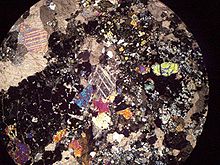

Skarns or tactites are coarse-grained metamorphic rocks that form by replacement of carbonate-bearing rocks during regional or contact metamorphism and metasomatism. Skarns may form by metamorphic recrystallization of impure carbonate protoliths, bimetasomatic reaction of different lithologies, and infiltration metasomatism by magmatic-hydrothermal fluids.[1] Skarns tend to be rich in calcium-magnesium-iron-manganese-aluminium silicate minerals, which are also referred to as calc-silicate minerals.[2][3][4][5] These minerals form as a result of alteration which occurs when hydrothermal fluids interact with a protolith of either igneous or sedimentary origin. In many cases, skarns are associated with the intrusion of a granitic pluton found in and around faults or shear zones that commonly intrude into a carbonate layer composed of either dolomite or limestone. Skarns can form by regional or contact metamorphism and therefore form in relatively high temperature environments.[2][3][4][5] The hydrothermal fluids associated with the metasomatic processes can originate from a variety of sources; magmatic, metamorphic, meteoric, marine, or even a mix of these.[4] The resulting skarn may consist of a variety of different minerals which are highly dependent on both the original composition of the hydrothermal fluid and the original composition of the protolith.[4]
If a skarn has a respectable amount of ore mineralization that can be mined for a profit, it can be classified as a skarn deposit.[2][3][4]
- ^ Einaudi, M. T.; Meinert, L. D.; Newberry, R. J. (1981), "Skarn Deposits", Seventy-Fifth Anniversary Volume, Society of Economic Geologists, doi:10.5382/av75.11, ISBN 978-1-9349-6953-3, retrieved 2023-07-14
- ^ a b c Einaudi, Marco T.; Burt, Donald M. (1982). "Introduction; terminology, classification, and composition of skarn deposits". Economic Geology. 77 (4): 745–754. Bibcode:1982EcGeo..77..745E. doi:10.2113/gsecongeo.77.4.745.
- ^ a b c Ray, G.E., and Webster, I.C.L. (1991): An Overview of Skarn Deposits; in Ore Deposits, Tectonics and Metallogeny in the Canadian Cordillera; McMillan, W.J., compiler, B. C. Ministry of Energy, Mines and Petroleum Resources, Paper 1991-4, pages 213-252.
- ^ a b c d e Meinert, L.D., 1992. Skarns and Skarn Deposits; Geoscience Canada, Vol. 19, No. 4, p. 145-162.
- ^ a b Hammarstrom, J.M., Kotlyar, B.B., Theodore, T.G., Elliott, J.E., John, D.A., Doebrich, J.L., Nash, J.T., Carlson, R.R., Lee, G.K., Livo, K.E., Klein, D.P., 1995. Cu, Au, and Zn-Pb Skarn Deposits, Chapter 12; United States Geological Survey: Preliminary Compilation of Descriptive Geoenvironmental Mineral Deposit Models: https://pubs.usgs.gov/of/1995/ofr-95-0831/CHAP12.pdf.